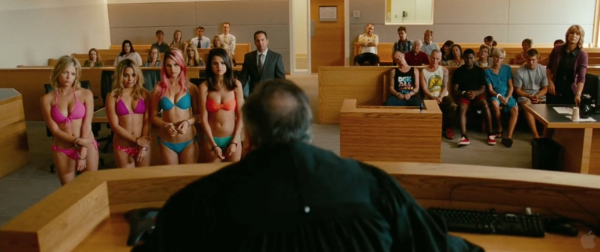2013 // USA // James Wan // September 14, 2013 // Digital Theatrical Projection (AMC West Olive 16)
[Note: This post contains spoilers for both Insidious and Insidious: Chapter 2.]
Director James Wan’s unexpectedly distinctive and skin-crawling 2010 feature Insidious established one of the high-water marks of mainstream American horror cinema in recent years. It did so not by creating anything especially original, but by assembling a cluster of familiar genre elements and narrative beats into a nonetheless unnerving and memorable ghost story. Most essentially, Insidious is just a damn creepy film, packed to its cobweb-cloaked rafters with uncommonly effective jump-scares, unsettling (if not terribly surprising) plot reveals, and a pall of dread that descends like a clockwork death-trap.
Insidious’ potency derives most conspicuously from Wan’s facility for crafting old-fashioned scares, which also owe a significant debt to the razor-sharp editing by the director and Kirk M. Morri, as well as the production design by veteran concept artist Aaron Sims. Sims’ work in the film generally foregrounds simple but striking characters and objects over fussy, Burton-esque phantasmagorical window dressing. Singular details such as the searing crimson visage of the Lipstick-Faced Demon (Joseph Bishara) or the gasmask-like contraption donned by medium Elise (Lin Shaye) prove more indelible than the somewhat anonymous houses (one musty, one modern) where the film’s ghostly events unfold. This bent to the design ends up dovetailing quite gratifyingly with the narrative focus on personalities and birthrights rather than the genre's usual emphasis on the voodoo of place.
Insidious also accomplishes a lamentably rare feat in the annals of horror filmmaking, in that it depicts characters who generally behave as actual people might when confronted with events of escalating supernatural bugfuckery. The spectral campaign of terror waged on the Lambert family by the entities that cluster around oldest son Dalton (Ty Simpkins) might unfold according to head-scratching haunted house logic, but the Lamberts and their allies are recognizably human in their responses. Wan and scripter Leigh Whannell mostly confine the film’s comic relief to ghost hunters Tucker (Angus Sampson) and Specs (Whannell himself). This allows the rest of the cast to play their reactions straight, albeit with a dose of horror flick hamminess in the cases of Shaye as Elise and Barbara Hershey as grandmother Lorraine. The effect is dire but darkly satisfying, like a funhouse drained of its escapist sense of mirth. Unlike William Castle or Sam Raimi, Wan doesn’t betray his relish for the viewer’s screams, which isn’t a Bad Thing by any stretch. Horror cinema needs more filmmakers who can acknowledge the hackish qualities of the genre and fulfill the fundamental money-for-scares exchange without necessarily winking at the audience.
Narratively speaking, Insidious has one serious speed bump. Prompted by a plea for help from a desperate and plainly guilt-wracked Lorraine, Elise arrives during the film’s second act to explicate both the family's hidden backstory and the rather twisty supernatural mythology that Wan and Whannell have devised for their tale. It’s an arguably essential pitstop on the route to Josh’s (Patrick Wilson) climactic rescue of his son from the spirit world (sorry, “the Further”), but it seriously disrupts the rhythm of the film, notwithstanding the presence of two exceptionally frightening scenes during this stretch of the story. (Those would would be Elise’s scribbled vision of the Lipstick-Faced Demon and the subsequent nerve-wracking seance sequence). It’s a bit like the toll that the viewer has to pay in return for preceding sixty minutes of boo!-packed craziness, which is terrifying in part due to its inexplicable character. This isn’t to say that the later exposition robs the film of its power, as the conventional wisdom about Insidious seems to have unfortunately concluded. If anything, the revelation that there is an otherworldly logic to the film’s occurrences makes for a much more absorbing story, but there’s no way around the fact Lorraine and Elise’s long-winded monologues disrupt Insidious’ cinematic momentum.
Which brings us to Insidious: Chapter 2, a work that was not in any sense necessary or inevitable given the first film’s bleak, smash-cut ending. Lo and behold, however, Chapter 2 proves to be quite a pleasure, both as a compelling continuation of the Lambert family’s story and as a damn fine horror feature in its own right. The sequel’s screenplay is a solo effort from Whannell, although he shares a story credit with Wan, and it’s a solid step up from the first chapter for one conspicuous reason: the absence of that dreaded late-film break to explain what the hell is going on. Granted, Chapter 2 still has its share of exposition, but Whannell sprinkles it more evenly through the film, ensuring that the viewer’s understanding of events is being advanced even as the scenes of horror unfold. Over on the left side of this spookhouse ride, long-suffering mom Renai (Rose Byrne) and to a lesser degree Dalton are terrorized by malevolent forces from the Further. To the right, Lorraine, Tucker, Specs, and Elie’s old confidant Carl (Steve Coulter) scurry around performing supernatural detective work. It’s not quite that clear-cut in practice, as some of the film’s best scares involve the latter group, and Renai’s ethereal encounters hold some vital clues. However, it’s a helpful way to conceive of the film’s structure.
Let’s back up: the prelude to Chapter 2 takes place some 24 years before the events of the first film, and depicts events to which Lorraine and Elise previously alluded. Responding to a fearful nocturnal appeal from fellow medium Carl (Hank Harris), Elise (Lindsay Seim) arrives at the home of doctor and single mom Lorraine (Jocelin Donahue) and her supernaturally sensitive son Josh (Garrett Ryan) in order to sniff out the ghostly presence that seems to have attached itself to the child. Once Elise puts Josh into a hypnotic trance, the boy guides her to the parasitic spirit, which proves so malevolent that Elise hastily concludes that the only safeguard against it is to completely mind-wipe Josh’s prodigious skill at astral projection. The Chapter 2 prelude is appropriately creepy, although far less elegant than the simple, mysterious roaming-through-a-dark-house sequence that opens the first film. Nonetheless, it establishes the sequel’s overall approach, which builds on the events of the original Insidious with remarkable fidelity, doggedness, and eccentricity. It’s an uncommon thing to witness in the realms of horror cinema, which is fairly notorious for sequels that arbitrarily disregard franchise continuity. The exception to this principle is the Saw series that Wan and Whannell themselves initiated and was eventually devoured by its own ridiculously convoluted plot.
The now two-film Insidious franchise has so far avoided this fate, in part by relentlessly foregrounding the first rule of horror cinema: Be Scary. Fortunately, Chapter 2 is just as chilling as its predecessor, and, if anything, is much more relentless about its rhythm of ominous lulls and white-knuckle shocks. The slow burn of the first film was a part of its pleasure, but it would have made little sense to attempt to replicate it in Chapter 2. Both the characters and the returning viewer understand the rules of the Further and are keenly aware of the malicious spirits that lurk there, so a different approach is needed, one that creates another level of esoteric lore in which to wade.
Chapter 2 picks up on the same night on which the preceding feature left off. The sequel’s first present-day scene consists of a slow zoom in on an police interrogation room, as a incredulous detective (Michael Beach) questions Renai about the events that left Elise strangled to death in the Lambert family’s living room. It’s an immensely gratifying shot, perfectly in keeping with the franchise’s sensibility of horror-tropes-plus-realism. It’s also arguably Byrne’s best scene in the whole film. Her tearful, exhausted manner is far more effective at taking the viewer back to that night than the flashback that elaborates unnecessarily on what exactly happened in the thirty seconds or so after Insidious’ concluding smash-cut. Eventually the Lambert family is released from custody, and the whole clan moves in with Grandma Lorraine until the police allow them back into their house.
Naturally, eerie phenomena start happening the moment that the family is settled, with most of the stranger sights and sounds seemingly focused on Renai, although pretty much everyone has a hard time of things. Lorraine spots spectral figures lurking in the halls, Dalton’s dreams are bedeviled by taunting voices and corpse brides, and Josh starts talking to himself and generally acting super-creepy. Meanwhile Tucker and Specs begin going through Elise’s personal effects, which leads them and a suddenly resurfaced Carl along a trail of breadcrumbs, and eventually to a disturbed (and long-deceased) man named Parker (Tom Fitzpatrick).
To their credit, the characters all suspect fairly quickly what has happened: the thing that returned from the Further in Josh’s body is not Josh at all, but the veiled crone that has haunted him since his childhood. This entity didn’t receive much attention in the first film, which featured a bevy of strange spirits but ultimately centered on Dalton’s entrapment by the Lipstick-Faced Demon. To a significant extent, the entirety of Chapter 2 plays out as Whannell’s response to the inevitable question, “Hey, what was the deal with that old lady?” Using this as the launching point for an whole film might seem a bit wobbly, if not an outright instance of authorial wankery. However, Wan and his performers do a fine job of keeping the tone and mood consistent with the previous chapter, and thereby heightening the sense that this is an actual sequel and not just a riff or a tangent. That said, there’s a gratifying bit of punk anger to the whole thing, as though Chapter 2 were a middle finger to viewers who found Insidious’ unanswered questions nagging. The filmmakers essentially pick one mystery from the first chapter and follow it down the rabbit hole, ultimately unearthing more questions than answers. Whether the individual viewer will find this fascinating or maddening may ultimately be a matter of personal taste, but the filmmakers certainly can’t be accused of coasting on or retreading their prior work.
This isn’t the same as completely disregarding what has gone before, of course, and Chapter 2 revisits quite a few elements from the first film. These aren’t so much callbacks as reminders of plot points that the viewer may have forgotten. Oh, that’s right: Renai is a pianist and composer. Oh, that’s right: Dalton is not just an astral projector like his father, but really goddamn good at it. Horror cinema has set a pretty low bar in this respect, making it strangely fulfilling to see a sequel where the filmmakers plainly re-read the earlier script before setting down to pen a new one. (What a concept!) The only truly indulgent callback is the sequence where a Further-delving Josh intrudes unseen on a scene from the original film, Back to the Future Part II-style. This unnecessarily soft-pedals a twist that any sensible viewer can puzzle out based on other clues—Josh can visit different times through the Further—and it adds nothing of value to the original scene.
Undoubtedly, touching upon a few familiar landmarks has value given that Chapter 2’s plot goes off in such a daft and knotty direction. The revelation that the veiled old woman that has tormented Josh for over two decades is actually the ghost of cross-dressing serial murderer Parker is fairly left-field, recalling The Exorcist III’s shoehorning of the Gemini Killer between the lines of the 1973 original. Just as weird is the disclosure that Chapter 2’s real villain is not Parker at all, but his unbalanced and hilariously manic mother, who forced a female identity on him as a child and ultimately goaded him into his crimes from beyond the grave. It’s hard to say whether all of this amounts to a cunning homage to Psycho, Sleepaway Camp, and Mommy Dearest, or just trans-exploitation (or both!), but it’s sure as hell isn’t typical.
The strange trajectory to its story notwithstanding, Chapter 2 ultimately sinks or swims on its merits as a device for delivering scares, and in this respect it’s arguably superior to its predecessor. Insidious has an intensely moody first half, but it does dawdle here and there on the domestic drama of the Lambert household. This isn’t a flaw per se in the original film, as characterization and scene-setting is theoretically needed before the oogie-boogie nuttiness really kicks in. Still, when the films are laid alongside one another, it’s apparent that Chapter 2 is comparatively remorseless with its shocks, hitting its stride early and keeping up a steady stream of subtle shadowplay, spine-tingling tension, and full-bore, shrieking madness.
If nothing else, Chapter 2 allows Patrick Wilson to descend into seething, menacing Jack Torrence mode. The Parker-possessed iteration of Josh is downright unsettling, and far afield from the faintly thick-witted Josh of the first film (“Me?”) or the weepy, sideburned Ed Warren of Wan’s tedious The Conjuring from earlier this year. The seriously nasty, teakettle-chucking, door-bashing brawl between Josh and the rest of the Lamberts is one of Chapter 2’s highlights, and a example of how the franchise approaches horror conventions from a slightly more gritty, believable angle. Just as stellar is Josh’s hair-raising confrontation with Carl, who with stomach-flopping dread rolls his spirit-talking dice to divine what object the other man is holding behind his back. The viewer (and Carl) knows exactly what letters are going to come up on that roll (K-N-I-F-E), and yet the moment is one of almost unbearable tension. It’s emblematic of all that the Insidious films get right: we know what is coming, we fear it, and we can’t look away.
[Post-Script: Overblown accusations of glaring plot-holes are already flying against Chapter 2, but here's the only one I can't really shake: Why did the forensics not reveal that Josh was the one who strangled Elise? It's an ineffective bit of misdirection, and as far as I can recall, the film never follows up on it.]








